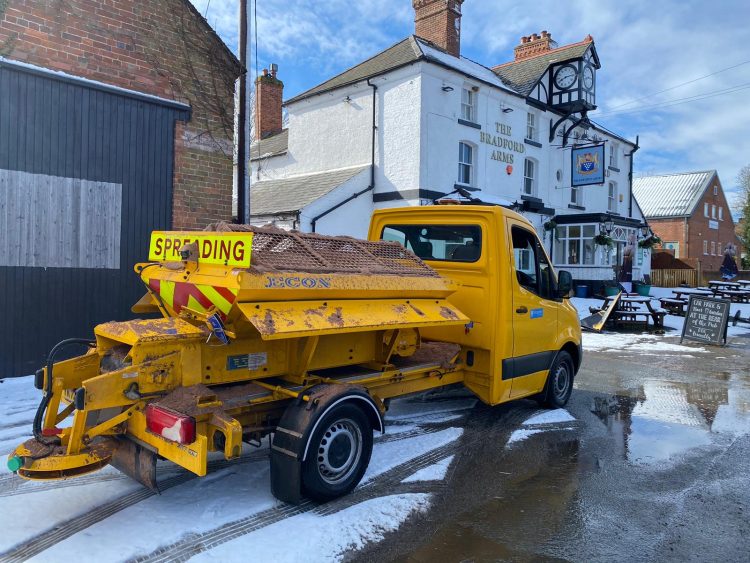Gritters to hit the roads for dry run ahead of winter

Some of the gritters based at Shrewsbury’s highways depot
Shropshire’s gritting teams will be out and about across the county this weekend (Saturday 5 October 2024), as they carry out their annual dry run ahead of winter.
Shropshire Council and its highways contractor Kier, has 25 gritters plus four reserve vehicles – along with nine footway ploughs, and nine snow blowers – ready to treat 25 gritting routes totalling 2353km (1462 miles).
Over the summer, work was carried out to ensure that vehicles and drivers are ready when ice and snow arrive. The gritters have been serviced and maintained, and over 22,000 tonnes of rock salt are now in stock across the council’s three highways depots.
This dry run is an essential part of this work, carried out to make sure the drivers re-familiarise themselves with the routes, gritters and any alterations, as well as making sure there are no problems with the fleet. All vehicles will be travelling slowly with warning lights to easily identify them to all road users. No grit will be used.
Shropshire Council’s’ fleet also includes a number of mini gritters, with crews on standby to treat high-risk areas including town centre roads, pavements and car parks.
And Shropshire Council also maintains 850 local salt bins during the winter, with people able to use salt from their local salt bins to treat pavements and roads.

One of Shropshire Council’s mini gritters in action last year
Dan Morris, Cabinet member for highways, said:
“A great amount of work and planning goes into keeping us all safe during the winter and our highways teams are prepared for when the worst of the weather hits.
“Every year, when the wintry weather arrives, our gritters and their fantastic help to keep the county’s roads safe and accessible during spells of ice and snow, and help to keep Shropshire moving in even the worst of the weather.
“Often working late at night, early in the morning, on weekends, and sometimes on bank holidays – we may not see them, but they’ll be out there when needed. That’s why I want to say a big thank you to all of our gritter drivers and crews for the work they will be carrying out in the coming months to keep our roads safe.”
Ian Mclellan, general manager, Kier Highways Shropshire added:
“Our drivers and fleet will be prepared for the cold snap ahead, as we’re carrying out dry runs of our gritting routes. We are in good stead for the challenges of winter weather conditions across Shropshire’s varied road network. Working together with Shropshire Council, our teams will be working hard behind the scenes to keep our roads, and the communities we work in, safe.”
The gritters are owned by Shropshire Council and located at the council’s highways depots in Shrewsbury, Craven Arms and Whittington.
In addition, many contractors and farmers have snow-clearing equipment and the council’s divisional officers deploy this supplementary equipment following heavy snowfall in rural areas.
For more information on Shropshire’s gritting routes and grit bins click here.
Further information
Where do we grit?
When ice or snow is predicted, pre-salting is carried out over priority roads, referred to as the defined network. This is around 28% of the total road network in Shropshire, and includes:
- All A and B roads
- Localised high-risk sites and important access routes
- Major town centre shopping areas
- Heavily used footways and cycle routes – during periods of prolonged sub-zero temperatures
How do we decide when to send the gritters out?
Shropshire Council and our contractors keep a weather-eye on temperatures throughout the winter.
We subscribe to weather forecasting services from The Met Office.
From October to April we get:
- A morning summary
- A 24-hour forecast each morning.
- A five-day forecast each afternoon.
- Ice prediction graphs each afternoon.
- Regular updates.
We also subscribe to a 24-hour consultancy service from The Met Office.
All that data helps us make informed decisions, but we also have inspectors on call that can go out and see the situation on the ground. These are officers with years of experience between them who know when to react to local conditions and deploy more resources as required.
When all the indicators are in place – generally when the road surface temperature is forecast to drop to zero or below – we’ll send the gritters out from our depots for what we call ‘pre-salting’. This is a preventative measure to stop ice forming on the roads.
In extreme circumstances, we’re aiming to remove ice that’s already formed, and that’s called post-salting.
Kier has sufficient drivers to operate all of the above routes 24 hours a day, and additional staff available to deal with other winter maintenance duties as required, e.g. clearing snow from footways.

